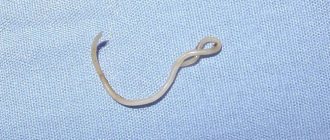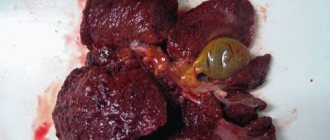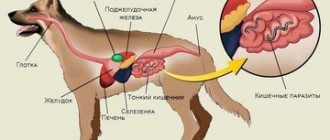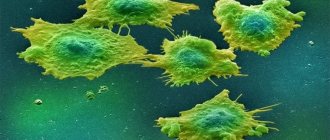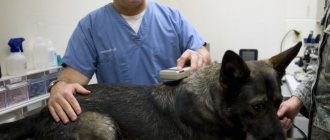Helminthic infestation is considered one of the most common pathologies in veterinary practice. In addition to the fact that parasites cause significant harm to the health of pets, some types of helminths are transmitted from animals to humans.
Among the existing varieties of worms, roundworms in dogs are especially dangerous. This article is devoted to the symptoms of their presence in the body and the features of treatment.
What to do in such a situation? To get started, we recommend reading this article. This article describes in detail methods of controlling parasites. We also recommend that you consult a specialist. Read the article >>>
Toxocara under high magnification
What are dog roundworms?
Roundworms (lat. Ascarididae) are a family of roundworms. The synonymous name for this type of worms is nematodes (lat. Nematoda). They belong to geohelminths, because. their eggs mature in the soil, where they are spread in the feces of infected animals, including dogs and cats.
The eggs mature and are then transferred into the dog's body through direct contact with the soil. Infection with roundworms is called ascariasis. It is most dangerous for puppies - their body will not yet be able to cope with the parasites on its own. The family includes 15 genera.
Two of them are important for a person:
- genus roundworm (Ascaris);
- genus Toxocara.
Toxocara
Pathogenesis and symptoms
The most common symptom associated with canine roundworm in puppies is a roundworm (a belly full of parasites). This often leads to blockage of the intestinal passage by worms, which, instead of exiting the body, go inside - into the stomach. As a result, the parasites come out along with the vomit.
Other symptoms include itchy skin (caused by a toxin produced by roundworms), oily coat, hives, loss of appetite, cramps, exhaustion, anemia, metabolic osteopathy, vomiting. A severe form of roundworm in dogs, which is not treated, can lead to the death of the puppy.
Types of helminths
The roundworm genus (Ascaris) is represented mainly by Ascaris lumbricoides and A. suum, which infect the small intestine of humans and pigs. The disease begins to be asymptomatic. People can become infected by swallowing food or water contaminated with worms.
Characteristics of roundworms:
- type: roundworms (nematodes);
- family: Ascarididae;
- genus: Ascaris (Ascaris).
They parasitize the small intestine. Characterized by large size. They have 3 protruding front lips and have sexual differences. Transmitted by the oral-fecal route.
Representatives of another genus of roundworms, Toxocara, parasitize the body of a cat or dog:
- in dogs - Toxocara canis;
- in cats - Toxocara cati.
Infection of a pet with Toxocara causes toxocariasis. In the larval stage, they can be transported along with the bloodstream to various tissues and organs of the body. And adult individuals will be in the intestines of the animal.
Important! If a dog has ever had roundworms, some dormant (“encysted”) larvae may remain in the body's tissues, even if the dog has been treated for worms. These encysted larvae can remain dormant for the rest of the animal's life or become activated when transmitted to puppies in utero.
What worms are transmitted from dogs to humans?
The possibility of transmission of helminths from dogs to humans exists. Because children often hug and kiss pets, they are more susceptible to helminth infection than other family members. In the post-Soviet space, 82 species of helminths have been registered, 32 of which parasitize humans, and 26 parasitize farm animals.
Roundworms called nematodes are considered universal parasites that migrate from dogs to humans.
List of helminths passing from a dog into the human body:
- hookworms (Toxocara canis and Toxascaris leonina);
- uncinaria;
- Echinococcus;
- heartworms;
- pork tapeworm;
- cucumber tapeworm.
Representatives of two families most often migrate from dogs to humans: Toxocara canis and Toxascaris leonina.
Some parasites enter the human body through the skin, some through the oral cavity
Most often, helminths migrate through the circulatory system to various organs and are encapsulated without ever reaching the stage of full maturation. However, in this form they provoke the development of toxocariasis, which in the acute stage is fraught with complications and even death. Symptoms are determined by the location of the worms. The disease is most clearly manifested when the liver, lungs and eyes are affected.
Table 2. Types of helminths and their effect on the human body
| View | Description | Method of infection | Symptoms |
| Hookworms (nematodes) | The larvae enter the body through the skin, when walking barefoot, for example. Then they migrate through the bloodstream and lymphatic system to the lungs and pharynx and are swallowed back into the gastrointestinal tract | Through the skin |
|
| Uncinaria (nematodes) | Getting deep into the skin, worms provoke urticaria and allergic dermatitis | Through the skin |
|
| Heartworms (nematodes) | It primarily affects the skin, less commonly the lungs or eyes. | Bite from a mosquito infested with larvae |
|
| Pork tapeworm (tape) | Attacks the mucous membranes of the small intestine. The dog is the intermediate host of the worm | Through meat containing helminth larvae |
|
| Echinococcus (ribbon) | Formation of cysts in the lung tissues and liver. It is asymptomatic, appearing only at the acute stage | By contact with an animal or while eating food contaminated with dog feces |
|
| Cucumber tapeworm (ribbon) | Malfunctions of the digestive organs | When swallowed by an infected flea or in the saliva of an infected dog |
|
| Toxocara canis and Toxascaris leonina (nematodes) | Larvae encapsulated in the body cause serious damage to human organs | Through any contact with an animal |
|
Timely deworming is the key to dog health
Helminth eggs remain viable in the environment for up to 3 years. Therefore, in addition to preventive measures, you should regularly disinfect the premises and monitor the quality of food consumed. To keep your pet vigorous and healthy, you need to be regularly examined by a veterinarian and have feces examined for the presence of parasites in the body.
Ascaris is a round helminth, up to 20 cm in length, that lives in the small intestine of most animals, including dogs. The female lays up to 20,000 eggs daily in her “host,” so the infestation quickly develops into a serious disease.
Life cycle of parasites
Development of roundworm:
- Fertilized eggs will be round oval in shape, brown in color, 45–75 µm long and 35–50 µm wide. They are excreted from the body along with feces.
- They develop in the soil, then enter the host’s body and grow to a larva (length 1.2–1.8 mm).
- They do not need an intermediate host, so the worms will spend the entire subsequent life cycle in a person (species A. lumbricoides) or in a pig (species A. suum). The grown larva develops into an adult: the female is 20–50 cm long, and the male is 15–30 cm long and 2–4 mm wide.
- Females begin oviposition 60–65 days after infection and produce huge numbers of eggs.
Adult roundworms can live from 6 months to 2 years, so their entire life cycle can range from 2 months to 5–10 years. Soil infection by roundworms is especially common where feces are used to fertilize vegetable crops. The development path of Toxocara, unlike roundworm, is considered complex. The eggs must be released into the soil, where they will mature in 5–36 days. Therefore, they are not dangerous in fresh feces. Ripening will occur only if the air temperature (+23°C) and humidity (at least 20%) are optimal for development.
Development of Toxocara:
- From the sand, the eggs enter the body of an intermediate host - a hare or mouse.
- There they go through the next stage of development - to the larva.
- They will enter the body of a cat or dog along with food eaten by the previous owner or through fleas, which are carriers of eggs.
- Here the worms will finish their development cycle and begin producing new batches of eggs.
Development cycle of Toxocara
The full development cycle of Toxocara sometimes takes several years and goes through several stages.
Stage 1. With the dog's feces, the eggs are released into the environment, more often into the soil, where they continue to develop. But they will become infectious only after an average of 20 to 30 days. Until this time, the egg is a spherical blastomere without a larva inside.
Within a month, the infected feces are broken down and the eggs appear on the soil surface. Withstanding the most unfavorable conditions, they are able to exist for several years until they penetrate the body of an intermediate host or are directly swallowed by a dog.
The role of intermediate hosts is played by small rodents, cockroaches, earthworms, livestock and humans.
Stage 2. In the stomach of the animal, the egg shell dissolves and the larva emerges. Through the intestinal wall it enters the general bloodstream, from where it migrates to the liver and remains there for 1-2 days.
After this, passing through the right heart, it penetrates the lungs and trachea. This type of migration is called hepatopulmonary. During the migration process, the larva undergoes its first molt.
But some larvae are characterized by a somatic type of migration - directly into the pulmonary vein. Such situations arise when a dog swallows a large number of eggs at the same time.
In this case, the larvae form into a cyst (encapsulate), and in this state they are able to exist in most internal organs, including the central nervous system, from several weeks to several months.
Stage 3. After the next stage of maturation, the larva leaves the cyst and moves with the bloodstream to the lungs, trachea and larynx. In a dog, this movement provokes a cough, due to which the larvae end up in the mouth, are re-swallowed and thus enter the intestines.
Stage 4. The last stage of molting occurs in the intestine, after which the larva becomes sexually mature.
What is ascariasis?
This is a parasitic infestation caused by the penetration of larvae and subsequent damage to internal organs by adult worms. When implying infection of a dog, it is correct to use the term toxocariasis.
Diagnostics
Ascariasis in dogs is caused by the nematode Toxocara, which is why the disease is called toxocariasis. In its type, the pathogen is completely similar to the human roundworm, and therefore poses a danger not only to the pet, but also to the owner and members of his family.
Like any nematode infestation, Toxocara can be diagnosed in three ways:
- A general blood test that helps to identify the presence of anemia, which is caused by helminthic infestation (it is almost never prescribed to animals, since it is of a general nature and does not allow an unambiguous conclusion to be made about the state of health and the presence of infestation);
- Fecal analysis helps determine the presence of eggs and larvae of worms, and sometimes adult individuals are also present in the sample (the test is effective only when ascariasis in dogs has reached the late intestinal stage, and the probability of infection is very high; at this stage, worms can often be seen in stool and without analysis;
- A blood test for the presence of antibodies to toxocariasis is one of the simplest and most reliable ways to determine whether an animal is a carrier of the infection, even at an early stage (it is good to use it, for example, when an animal that has not been treated against worms has come into contact with an infected individual).
Most often, veterinarians prescribe the third type of study. It is immunological in nature and is based on the knowledge that when a parasite enters the body, it begins to produce antibodies for protection.
Within a few days after infection, enough antibodies are present in the blood to indicate the presence of an invasion. However, antibodies may also be present in those pets who have had the disease previously.
The test result will be negative when enough time has not passed since the infection and antibodies have not had time to develop. This also happens in the later stages, when the body stops fighting the invasion (in this case, analysis is rarely prescribed, since worms in the stool are visible visually). And of course, in cases where the pet is healthy.
There is also a borderline state when the amount of antibodies is not enough to make a diagnosis, but they are present in such quantities that it is also impossible to talk about the absence of invasion. In this case, the veterinarian makes a conclusion based on the presence or absence of symptoms and the typicality of the clinical picture.
Video from a veterinarian: how to treat ascariasis in a puppy
Ascariasis is not a dangerous disease if diagnosed early and treated correctly. A caring, attentive owner will immediately recognize the symptoms of infestation and take action.
The parasite is roundworm. The owner is representatives of the Canidae family (dogs, foxes and others).
Roundworms in dogs cause the disease ascariasis or toxocariasis. This is one of the most common endoparasitic diseases in dogs. Although it may seem like a minor problem that will go away with antiparasitic medication, it can cause significant harm to large breeding dogs.
The best method of prevention is to control dog feces. However, for most dog breeders this procedure is quite expensive, so they choose the second option - deworming.
Unfortunately, few dog owners know the life cycle of roundworm in order to be able to prevent the development of a disease such as ascariasis in dogs. In this case, owners can periodically administer medications to their pet against these parasites. If roundworm is detected in a dog, this is not enough.
How can a dog become infected?
A dog becomes infected with Toxocara in the following situations:
- along with mother's milk or in the prenatal period;
- when swallowing soil or water contaminated with larvae;
- when eating a Toxocara Canis carrier.
Important! A female Toxocara manages to lay up to 200,000 eggs per day. It is believed that its lifespan in a dog’s body is 4
Are they transmitted to humans?
The possibility of infecting people with roundworms of an unusual species exists.
For example, Toxocara eggs can enter the human body accidentally:
- if he ate a flea;
- due to failure to comply with hygiene rules when in contact with contaminated soil.
When considering the issue of infection with roundworms, one must remember that their species specificity depends on the body temperature of the host animal. Thus, the body temperature of a mouse is within the range of 37°C–39°C, that of a dog is 37.5°C–38.5°C, and that of a human is 36.3°C–36.9°C. Therefore, roundworms develop in humans, and Toxocara is encapsulated and does not enter the stage of puberty. But the worms still grow and, together with the bloodstream, can settle in various tissues and organs, becoming the cause of new diseases.
Important! If you see white spots the size of a grain of rice, then these are other parasites - tapeworms. They are carried by fleas.
Other methods of infection
In addition to the transmission of worms from mother to offspring, there are easier ways of infection. In 90% of cases, the disease develops when helminths penetrate into the external environment (or, more precisely, their larvae), after which they become swallowed by the dog. In nature, it is rarely possible to detect worm eggs, since they quite often live in food and water. Therefore, while feeding, playing, for example, with a bone, as well as with severe thirst, the pet can easily swallow helminth eggs.
Often the symptoms of roundworm can be noticed in a dog when he has eaten an infected animal. For example, roundworms often live in such individuals as:
- rats;
- mice;
- hamsters;
- frogs.
In such creatures, the worms will not grow to a large size, however, if they are eaten by a dog, the growth of worms will actively begin.
What to do?
Treatment with drugs
- Gelmex is acceptable for treating even 3-week-old puppies; minimum side effects.
- Tenac has a wide spectrum of action: it is effective not only against Toxocara, but at the same time destroys tape and whip-shaped parasites. Strictly contraindicated in dogs with heartworms and does not allow wearing a flea collar. In this case, Tenac is replaced by Verkom, Caricide, Panacur or Mebendazole.
- Milbemax is an effective product flavored with the smell of meat.
- Prazitel is a suspension for both puppies and adult dogs.
- Kanikquantel is a highly toxic drug. Eliminates ascaris after a single dose. It is prescribed to puppies with great caution.
- Helminthal C – used to eliminate roundworm eggs in a dog’s fur.
the drug Ivermectin is strictly contraindicated for puppies under 4 months and dog breeds with a dolichocephalic head shape: collies, collie mixes, some terriers, bobtails, shelties and briards. There is a threat of severe intoxication with fatal outcome.
Drontal or Drontal plus and oxybendazole-based products also show excellent results For example, Polyverkan .
Regardless of the specific drug, in most cases treatment is repeated after 2 or 3 weeks. In this way, the maximum number of constantly migrating larvae will be destroyed.
Deworming at home
The dosage of any anthelmintic drug should be selected by a veterinarian in strict accordance with the weight of the dog. Particular caution is exercised when prescribing dosages for puppies. Treat toxocariasis exclusively in the clinic.
Can they go out on their own?
Spontaneous release of roundworms with excrement or vomiting occurs in cases where the number of helminths has become critical. In such a situation, the animal needs emergency veterinary care.
In pregnant women, lactating women and puppies
Somatic larvae are localized in the heart, lungs, muscles, kidneys and liver of the bitch infected before pregnancy. Under hormonal influence during pregnancy, they are transformed from hypobiosis and find themselves in the systemic circulation.
In the last trimester of pregnancy, Toxocara penetrates the fetus through the placenta. In the first days after birth, the larvae are found in the lungs of puppies, and already on the 10th day they can be found in the duodenum.
In the small intestine of babies, they finally reach puberty. And the somatic larvae that have reached the mammary glands begin to be actively excreted along with milk a few days after birth.
With ascariasis, age-related resistance to infection is quite clearly expressed. The older the dog, the more larvae undergo only somatic movement, and the fewer of them ultimately penetrate the intestines.
But in puppies less than 1 month old, the migration of larvae occurs according to the hepatopulmonary type with rapid intestinal localization. As a result, the largest number of roundworms is localized in the body of a three-month-old puppy.
With adequate timely treatment, this number continues to decrease, and by an older age, either somatic larvae or a small number of adult roundworms may be seen in the dog.
Treatment of toxocariasis
Adult dogs rarely have worms in their intestines. With age, resistance to their destructive effects develops. In addition, most of the larvae are encapsulated in other organs after leaving the intestine. Therefore, it is necessary to treat puppies or young animals.
An important point in treating the disease is disinfection of the space in which the pet lives. To do this, you need to clean his sleeping place and regularly wash the floors with an antibacterial agent.
Therapy involves the use of antiparasitic medications. The following drugs are prescribed to combat helminths:
- "Kaniquantel plus";
- "Prasitel";
- "Milbemax";
- "Panacur";
- "Dosalid";
- "Drontal";
- "Triantelm."
At the first sign of roundworm, treatment should be started immediately.
"Prasitel" is an effective anthelmintic agent
Features of using "Prasitel"
The drug contains the active substances praziquantel and pyrantel pamoate, which successfully fight nematodes.
Thanks to these components, parasites are neutralized at various stages of their formation, from eggs to mature worms.
The product is produced in the form of tablets and solution.
Table 1. Method of using Prazitel
| Indicators | Puppies | Mature dogs |
| Pet age | 2 weeks | 6 months |
| Required quantity (suspension) | 1 ml per 1 kg of weight | 1 ml per 10 kg weight |
| Required quantity (tablets) | 1 tablet per 1 kg of weight | 1 tablet per 10 kg body weight |
A large puppy should be given Prazitel Plus at the rate of 1 ml per 10 kg of weight. For a small mature dog - Prazitel at the rate of 1 ml per 1 kg.
Features of taking the medicine:
- prevention - once every 3 months;
- vaccination - 10 days before;
- mating - in 2 weeks.
During the deworming period, it is important to constantly disinfect the room.
General recommendations for deworming dogs
Video - How to deal with worms in a puppy. Ascariasis
It is possible to defeat parasites!
Antiparasitic Complex® - Reliable and safe removal of parasites in 21 days!
- The composition includes only natural ingredients;
- Does not cause side effects;
- Absolutely safe;
- Protects the liver, heart, lungs, stomach, skin from parasites;
- Removes waste products of parasites from the body.
- Effectively destroys most types of helminths in 21 days.
There is now a preferential program for free packaging. Read expert opinion.
Interesting to know:
Bibliography
- Centers for Disease Control and Prevention. Brucellosis. Parasites. Link
- Corbel MJ Parasitic diseases // World Health Organization. Link
- Young EJ Best matches for intestinal parasites // Clinical Infectious Diseases. — 1995. Vol. 21. - P. 283-290. Link
- Yushchuk N.D., Vengerov Yu.A. Infectious diseases: textbook. — 2nd edition. - M.: Medicine, 2003. - 544 p.
- Prevalence of parasitic diseases among the population, 2009 / Kokolova L. M., Reshetnikov A. D., Platonov T. A., Verkhovtseva L. A.
- Helminths of domestic carnivores of the Voronezh region, 2011 / Nikulin P. I., Romashov B. V.
An article for patients with a doctor-diagnosed disease. Does not replace a doctor's appointment and cannot be used for self-diagnosis.
The best stories from our readers
Topic: Parasites are to blame for all troubles!
From: Lyudmila S. ()
To: Administration Noparasites.ru
Not long ago my health condition worsened. I began to feel constant fatigue, headaches, laziness and some kind of endless apathy appeared. Problems also appeared with the gastrointestinal tract: bloating, diarrhea, pain and bad breath.
I thought it was because of the hard work and hoped that it would go away on its own. But every day I felt worse. The doctors couldn’t really say anything either. Everything seems to be normal, but I feel like my body is not healthy.
I decided to go to a private clinic. Here I was advised, in addition to general tests, to get tested for parasites. So in one of the tests they found parasites in me. According to doctors, these were worms, which 90% of people have and almost everyone is infected, to a greater or lesser extent.
I was prescribed a course of antiparasitic medications. But it didn’t give me any results. A week later, a friend sent me a link to an article where some parasitologist shared real tips on fighting parasites. This article literally saved my life. I followed all the advice that was there and after a couple of days I felt much better!
Digestion improved, headaches went away and the vital energy that I so lacked appeared. To be sure, I took the tests again and no parasites were found!
Anyone who wants to cleanse their body of parasites, no matter what types of these creatures live in you, read this article, I’m 100% sure it will help you! Go to article>>>
Still have questions? Ask them in our Anonymous group on VK
How to get rid of parasites in a week. The answer is here!
A reliable and effective remedy for combating worms. Removes all parasites in 21 days.
Go to website
Reviews
Read online
Symptoms that 100% indicate parasites! Take the Test.
How to rid your body of life-threatening parasites before it’s too late!
Read more
Website
To get a consultation
The doctor tells how to quickly get rid of parasites for adults and children!
A parasitologist explains what effective methods exist to combat helminths.
More details
Read completely
Comments
Search for cures for parasites
This service is a small help in finding cures for parasites. To start using it, select the type of parasite. If you don’t know what kind of parasite you are infected with, this parasite identification tool will help you by symptoms.
We recommend reading
Toxoplasmosis in dogs: routes of infection, symptoms and treatment
1 week ago 01/29/202102/1/2021ecoliv94
Worm inspector for cats: instructions for use, cost
1 week ago 01/27/202102/02/2021ecoliv94
Products for cats against ticks and worms: list of the best
2 weeks ago 01/25/202102/3/2021ecoliv94
Dirofen against worms for cats and dogs: instructions for use, price, analogues
2 weeks ago 01/25/202102/3/2021ecoliv94

